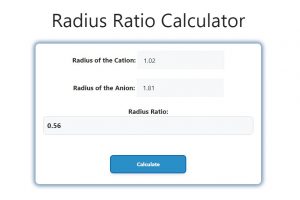About Radius Ratio Calculator (Formula)
The Radius Ratio Calculator is a valuable tool in the field of chemistry, particularly in the study of ionic compounds. It helps determine the stability of ionic structures by comparing the sizes of cations and anions. The radius ratio (RR) plays a crucial role in predicting the coordination number of ions in a crystal lattice, which directly impacts the physical properties of the compound, such as solubility, melting point, and lattice energy. Understanding the radius ratio is essential for chemists and materials scientists when designing new materials and studying existing compounds.
Formula
The formula for calculating the radius ratio is:
Radius Ratio (RR) = Radius of the Cation / Radius of the Anion.
This equation provides a quantitative measure of the size relationship between cations and anions in ionic compounds.
How to Use
Using the Radius Ratio Calculator involves the following steps:
- Identify Ion Types: Determine the cation and anion for the ionic compound you are studying.
- Measure Radii: Obtain the ionic radii of both the cation and anion from a reliable source, such as a chemistry textbook or database.
- Input Values: Enter the radius of the cation and the radius of the anion into the calculator.
- Calculate Radius Ratio: Use the formula to calculate the radius ratio, which will help assess the stability of the ionic compound.
- Interpret Results: Analyze the radius ratio to understand the potential coordination number and stability of the ionic structure.
Example
Suppose you are analyzing sodium chloride (NaCl). The ionic radii are approximately:
- Radius of Sodium Ion (Na⁺): 1.02 Å
- Radius of Chloride Ion (Cl⁻): 1.81 Å
To calculate the radius ratio:
RR = Radius of the Cation / Radius of the Anion
RR = 1.02 Å / 1.81 Å ≈ 0.56.
This value indicates the relative sizes of the ions in the compound, suggesting a coordination number of 6 for NaCl, which is characteristic of its cubic crystal structure.

FAQs
1. What is a radius ratio in chemistry?
The radius ratio is the ratio of the ionic radius of a cation to the ionic radius of an anion, used to assess the stability of ionic compounds.
2. Why is the radius ratio important?
It helps predict the coordination number of ions in a crystal lattice and influences the physical properties of ionic compounds.
3. How do I find the ionic radii?
Ionic radii can be found in chemistry textbooks, research articles, or online databases dedicated to ionic compounds.
4. What does a higher radius ratio indicate?
A higher radius ratio suggests that the cation is relatively larger compared to the anion, which can affect the stability and structure of the ionic compound.
5. Can the radius ratio help predict crystal structures?
Yes, it provides insights into possible crystal structures and coordination numbers for ionic compounds.
6. What is the typical range for radius ratios in stable ionic compounds?
Radius ratios typically range from 0.414 to 0.732 for stable ionic compounds, indicating a coordination number of 6.
7. What happens if the radius ratio is too low?
A very low radius ratio may indicate instability in the ionic compound, leading to potential structural issues.
8. How does the radius ratio relate to lattice energy?
A suitable radius ratio often correlates with higher lattice energy, contributing to the compound’s stability.
9. Can I use the radius ratio for covalent compounds?
No, the radius ratio is specifically applicable to ionic compounds where cations and anions are present.
10. How does temperature affect ionic radii?
Ionic radii can change slightly with temperature due to thermal expansion, which can affect the radius ratio calculations.
11. What is the significance of coordination number?
The coordination number indicates how many ions of opposite charge surround a particular ion in a crystal lattice, affecting stability.
12. Are there exceptions to radius ratio predictions?
Yes, some ionic compounds may exhibit unusual stability despite having radius ratios outside the expected range due to other factors.
13. How do electronegativity and ionic size relate?
Electronegativity differences can affect ionic sizes, and understanding this relationship can enhance predictions about ionic compound stability.
14. What role does ionic size play in solubility?
The size of ions influences the solubility of ionic compounds; larger ions may result in lower lattice energies and increased solubility.
15. Can the radius ratio change in different phases of matter?
Yes, ionic sizes may vary between solid, liquid, and gas phases, potentially altering the radius ratio.
16. How often should the radius ratio be calculated?
It is essential to calculate the radius ratio whenever analyzing new ionic compounds or studying existing ones for comparative purposes.
17. Can radius ratios be used in industrial applications?
Yes, they are used in materials science to design and optimize ionic compounds for specific applications.
18. What is the impact of ion polarization on the radius ratio?
Ion polarization can affect ionic radii and subsequently influence the radius ratio, altering compound stability.
19. Can radius ratios help in environmental chemistry?
Understanding ionic stability can aid in predicting the behavior of ionic compounds in environmental contexts, such as solubility and mobility.
20. How can the radius ratio affect biological systems?
Ionic stability and interactions are crucial in biological systems; radius ratios can influence enzyme activities and metabolic pathways.
Conclusion
The Radius Ratio Calculator is a crucial tool for understanding the stability of ionic compounds and predicting their properties based on the size relationship between cations and anions. By analyzing the radius ratio, chemists and materials scientists can make informed decisions about compound stability, crystal structure, and potential applications. This understanding aids in the design of new materials and contributes to advancements in chemistry and related fields.